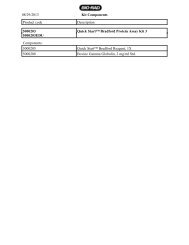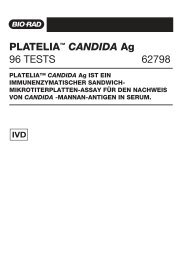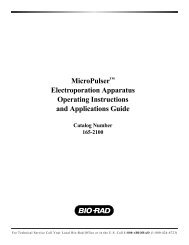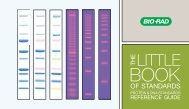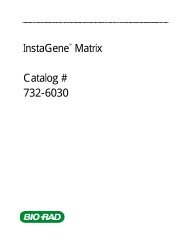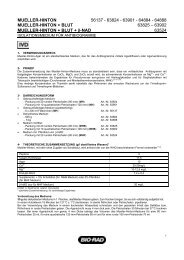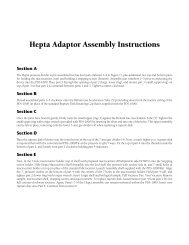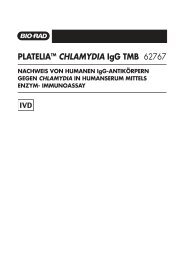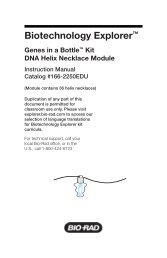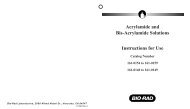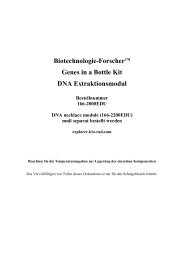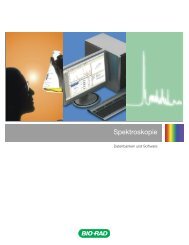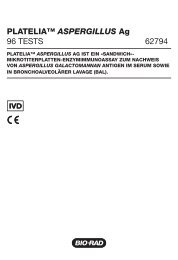Protein Expression and Purification Series - Bio-Rad
Protein Expression and Purification Series - Bio-Rad
Protein Expression and Purification Series - Bio-Rad
You also want an ePaper? Increase the reach of your titles
YUMPU automatically turns print PDFs into web optimized ePapers that Google loves.
CHAPTER 1<br />
BACKGROUND<br />
<strong>Protein</strong> <strong>Expression</strong> <strong>and</strong> <strong>Purification</strong> <strong>Series</strong><br />
order for the reaction to occur. NADPH is a cofactor that carries electrons from one reaction to another for<br />
use in metabolic enzymatic reactions.<br />
The conversion of DHF to THF by dihydrofolate reductase<br />
in the presence of NADPH is an example of a classical<br />
oxidation-reduction reaction. Oxidation is defined as<br />
the loss of at least one electron, while reduction is the<br />
gain of that electron. In the case of organic compounds,<br />
oxidation is the loss of a hydride ion (H - ), or a negatively<br />
charged hydrogen ion that consists of two electrons <strong>and</strong><br />
one proton. The NADPH donates a hydride ion to DHF,<br />
<strong>and</strong> when this hydride ion reacts with a specific bond of<br />
DHF, it removes the existing double bond <strong>and</strong> is covalently<br />
bound to the carbon group producing THF. Dihydrofolate<br />
reductase catalyzes the reactions shown in Figure 1.14. As<br />
shown, the NADPH loses a hydride ion that is transferred<br />
to DHF converting it to THF.<br />
To measure the enzymatic activity of dihydrofolate<br />
reductase, a methodology needs to be developed to<br />
track the disappearance of NADPH or DHF or conversely<br />
to measure the appearance of NADP + or THF. For every<br />
molecule of NADPH that is converted to NADP + by the<br />
enzyme dihydrofolate reductase, one molecule of THF<br />
is produced from the substrate DHF. Unfortunately,<br />
none of these four compounds are colored so there is<br />
no way to directly visualize the reaction. However, it is<br />
possible to measure the rate of this reaction using a<br />
Figure 1.14. The conversion of DHF to THF. NADPH<br />
transfers a hydride ion to DHF, converting it to THF.<br />
spectrophotometer than can detect light in the UV range. NADPH absorbs light in the UV range at 340 nm.<br />
However, when NADPH is converted to NADP + , it no longer absorbs at 340 nm. Therefore, by measuring<br />
the decrease of absorbance at 340 nm of a reaction containing a known quantity of DHF, NADPH <strong>and</strong><br />
dihydrofolate reductase, the reaction rate that NADPH is converted to NADP + can be calculated.<br />
In this laboratory series, students will recombinantly make <strong>and</strong> purify human dihydrofolate reductase as<br />
a fusion construct with GST <strong>and</strong> a histidine tag (GST-DHFR-His). The concentration of the purified GST-<br />
DHFR-His will be calculated using the proteins’ intrinsic absorbance of UV light at 280 nm. This known<br />
concentration of GST-DHFR-His will then be first combined with a known quantity of NADPH. Since no<br />
DHF substrate is present, the NADPH should not be reduced <strong>and</strong> the absorbance at 340 nm over time<br />
should be constant. Once the substrate DHF is added to the solution containing the purified GST-DHFR-<br />
His <strong>and</strong> NADPH, the absorbance at 340 nm should decrease over time as the reaction occurs converting<br />
NADPH to NADP + <strong>and</strong> DHF to THF.<br />
48 Chapter 1: Recombinant <strong>Protein</strong> <strong>Expression</strong> & <strong>Purification</strong>



